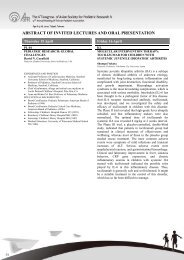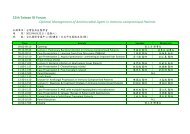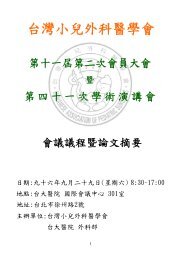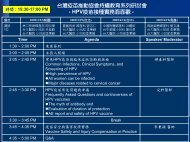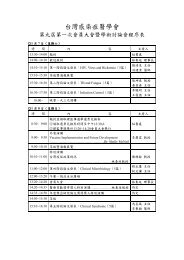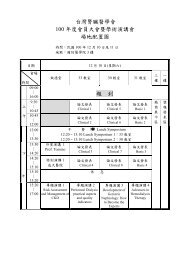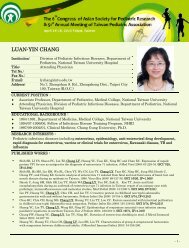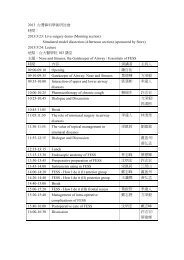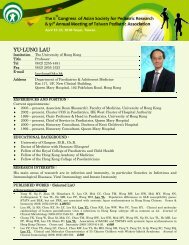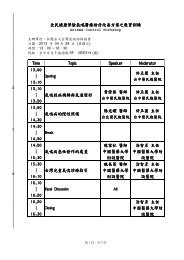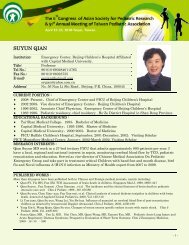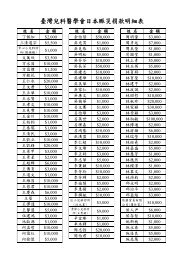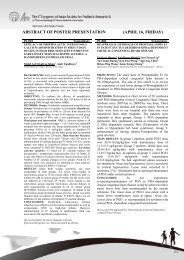ABSTRACT OF POSTER PRESENTATION (APRIL 17, SATURDAY)
ABSTRACT OF POSTER PRESENTATION (APRIL 17, SATURDAY)
ABSTRACT OF POSTER PRESENTATION (APRIL 17, SATURDAY)
Create successful ePaper yourself
Turn your PDF publications into a flip-book with our unique Google optimized e-Paper software.
P2-051 Neuropsychiatry (Neurology) P2-052 Neuropsychiatry (Neurology)PREVALENCE <strong>OF</strong> DEVELOPMENTALDISABILITY CHILDREN IN NORTHEAST <strong>OF</strong>TAIWANHui-Ju Chen 1 , Nan-Chang Chiu 2,3 , Hung-Chi Lue 1 ,Lo-Lin Tseng 11 Department of Pediatrics, Saint Mary’s Hospital Luodong, Taiwan,2 Department of Pediatrics, Mackay Memorial Hospital, Taipei, Taiwan,3 Mackay Medicine,Nursing and Management College, Taipei, TaiwanBACKGROUND: Since early identification of children withdevelopmental disability and early intervention can improve theoutcome, we conducted a developmental screen program to detectthe developmental delay children and estimate the prevalence ofdevelopmental disability children in northeast of Taiwan.PATIENT & METHODS: We enrolled children between 4months and 6 years of age from July 2008 to December 2009.Taipei City Developmental Screening Checklist for Preschoolers,version 2(Taipei Ⅱ) was used as the screening tool. Parents orcaregivers completed the screening checklist while waiting forchild health examination or vaccination at local clinics in I-Lan orin Saint Mary’s Hospital Luodong. The screening results wereexplained immediately by the visited pediatrist. The results of thescreen were divided into three groups: (1) normal (no failureitem), (2) follow-up (one failure item), and (3) suspecteddevelopmental delay (more than two failure items). In thesuspected developmental delay group, the children were referredto the pediatric neurologist for further neurological examinationand performing Denver Developmental Screen Test (DDST). Inthe follow-up group, the children were rechecked 2 to 6 monthslater by the screening checklist (Taipei II) again; if the failureitems were still more than one, the children then were referred tothe pediatric neurologist, too. The mother country, income andeducation level of the parents were also analyzed.RESULTS: Among the 3151 screened children, 2744 (87.1%)passed the screen checklist, 240 (7.6%) failed to pass one item inthe first screen and need further follow up, and 167 (5.3%) weresuspected developmental delay. Of the follow-up children,34(1.1%) children were screened as suspected developmentaldelay later. Further neurological examination and DDSTperformed in <strong>17</strong>3 patients revealed normal in 11 children (0.35%),borderline developmental delay in 41 children (1.30%); and in 120children (3.8%) significant developmental delay were found andthey were referred to early intervention program. The diagnosis ofthe 161 developmental delay children included speech andlanguage delay/disorders (n=96, 3.04%), , autistic spectrumdisorder (n=12, 0.38%), mental retardation (n=6, 0.19%), globaldevelopmental delay (n=21, 0.67%), attention deficit hyperactivitydisorder (n=26, 0.82%), motor delay (n=28, 0.89%), infantilecerebral palsy (n=11, 0.35%), syndromic disorder/congenitalanomaly (n=8, 0.25%), hearing impairment (n=2, 0.07%), etc.Low parental income, low parental education level and aboriginewere associated with their children’s developmental delay.CONCLUSIONS: The prevalence of developmental disability inour study is 6.4%. The most common disability disorder is speechand language delay/disorders follows by attention deficithyperactivity disorder. Environmental factors including aboriginefamily, parental education level and income are associated withtheir children’s screening result.[Keywords]developmental disability, developmental disorder,screeningVAGUS NERVE STIMULATION TREATMENTFOR CHILDHOOD REFRCCTORY EPILEPSY INCHANG GUNG CHILDREN MEDICAL CENTER<strong>OF</strong> TAIWANChuan-Yu Wang, MD, PhD 1 *, Chen-Nen Chang, MD 2 *,Hsu-Tung Lee, MD 3 * and Dah-Chin Yan, MD 4 *1 Taipei division of Pediatric Neurology , Chang Gung Children Hospital , Linko,Taiwan; 2 Department of Neurosurgery, Chang Gung Memorial Hospital, Linko,Taiwan; 3 Department of Neurosurgery, Taichung Veterans General Hospital,Taiwan; 4 Taipei division of Pediatric Immunology , Chang Gung ChildrenHospital ,Linko, TaiwanPURPOSE: Vagus Nerve Stimulation (VNS) isapproved by FDA in 1997 for adjunctive therapy formedical intractable epileptic patients. In Taiwan, the firstModel 102 VNS was implanted since August,2007(almost adult patients) under informed consent andIRB certification. To investigate VNS effect forPediatric' patient, we collected intractable epilepticchildren for this study.METHODS: 7 refractory epileptic patients aging from2~<strong>17</strong> Y/O were enrolled into the study and the data of 3months before VNS implantation, including seizuredairy and quality of life variables, and the patients werefollowed for 1 year. Patients’ classification of epilepsyincluded 2 Lennox-Gastaut syndrome, Autism withlocalized epilepsy, Progressive Myoclonic Epilepsy,Rasmussen syndrome, Severe migration partial seizuresin infancy, Cryptogenic parietal lobe epilepsy. Theseizure reduction rate, EEG, BAEP, SPECT, brain MRIand intelligence test were done before and afterperformance of VNS for 1/2~1 year.RESULTS: The seizure reduction rate was more than50% in all patients, and EEG showed mild ameliorationof spikes foci frequency (5/7), and interictal SPECTshowed elevation of perfusion over basal ganglia ordiffuse cortical areas in most patients (4/7) after VNSimplantation. Life quality quotient test and Depressionquotient test were both improved, but IQ test improvedjust a little without significant change. BAEP and brainMRI were not changed.CONCLUSION: (1) Seizure reduction rates weremore than 50% after implantation for 1 year in thesecases; (2) Quality of life, such as: alertness, mood andlanguage function improved prominently; (3) EEG,SPECT were improved with mild degree; (4) Partialseizure is eliminated prominently in seizure reduction byVNS therapy, and focal discharges were diminishedeasily than generalized one. (5) The relationship betweenVNS performance and parameter setting will be stillunder investigation.[Keywords] vagus nerve stimulation, parameter setting, seizurereduction, quality of life improvement280



